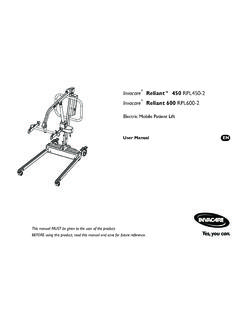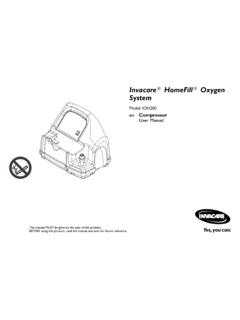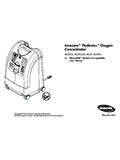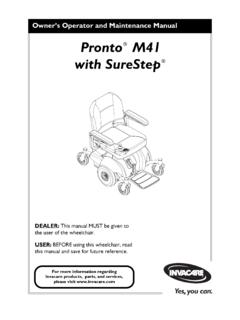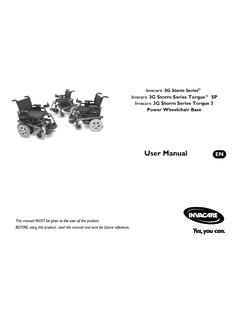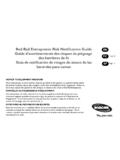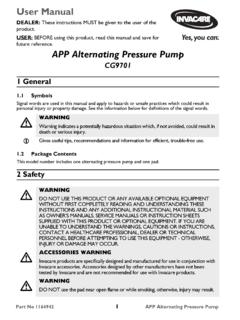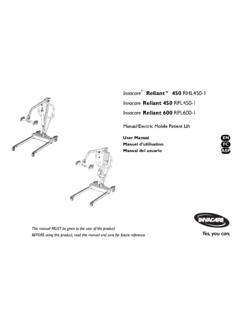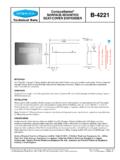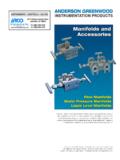Transcription of 3G Tilt-in-Space Wheelchair Accessories Coding …
1 E1161 Manual adult size Wheelchair , includes Tilt-in-Space (SOLARA 3G E1161 Pending PDAC Approval)Allowable: $2, - $2, WC, pediatric size, Tilt-in-Space , rigid, adjustable, without seating system (SPREE 3G E1233 Pending PDAC Approval)Allowable: $1, $2, : Permits rotation of seating system posteriorly andlaterally while the hip angle remains constant Distributes pressure over a larger area Improves midline stability with more effectiveposterolateral control and spinal extension Improves bone integrity and reduces contractures Slows down the progression of a neurologically basedspinal deformity Facilitation of axial and peripheral active motion Provides edema control in lower extremities Improves respiration and digestion Inhibits abnormal tonal patterns and primitive reflexes Needed due to endurance deficits in sitting requirementfor, weight shifting for skin integrity Client is non-self positioning with extensor tone; thiswill aid in tone management.
2 Needed to allow independent changes in positionthroughout the day, client is without a caregiver andmust be able to accomplish tilted position to aid in adultdaily activities Allows the client to tilt back slightly to utilize gravity tohelp with balance due to poor trunk control Allows safe pressure relief by increasing the seatingsurface area, and redistributing pressure away fromcritical areas of the pelvis Can allow independent performance of weight shifts Can be effectively used with limited hip range of motion Allows for nonexistent to minimal functional sheareffect during tilt cycles Can decrease fatigue associated with high muscle tone Can increase sitting tolerance throughout the day Allows gravity to assist caregiver with positioning theclient after transfers Allows gravity to assist with repositioning in the systemduring the day May reduce caregiver attendant hours requiredsecondary to independence with weight shifts Can allow gravity to assist with positioning the user inback and seat supports Maintains body angles and position relative to seat andback support surfaces during the tilt cycle Absent to minimal triggering of abnormal muscle tone orreflexes Accommodates easiest to extremity contractures
3 Accommodates easiest to trunk or postural asymmetries Considered a comfort position by many Wheelchair users May help to relax increased muscle tone Allows easier swallowing for some due to more relaxedmuscle tone and improved positioning Can facilitate management of lower extremity edema,more effectively when combined with elevating legrest Can reduce respiratory difficulty through decreasingpressure on the diaphragm and facilitating an extensionof the spine/trunk Can improve the 'line of sight' May allow the client to independently initiate sittingupright during hypertensive episodes Client is unable to weight shift, creating risk for skinbreakdown Client has severe deformity that requires tilt for clearvisual field Client lacks trunk control, tilt allows them to sit with anupright posture tilt reduces abnormal posture that contributes to poorswallowing 2009 Invacare Corporation. All rights reserved.
4 Republication or duplication in whole or any part of any content is prohibited without the prior written permission of Invacare, One Invacare Way, Elyria, OH 44035. Invacare owns all trademarks shown unless otherwise 3G Tilt-in-Space Wheelchair Accessories Coding and JustificationSpecial NoteHCPCS codes are not intended to be, nor should be considered billing or legal advice. Providers are responsible for determining the appropriate billing codes when submittingclaims to the Medicare Program and should consult an attorney or other advisor to discuss specific situations in further Nonstandard seat frame, width 20-23 inchesE2202 Nonstandard seat frame, width 24-27 inches E2203 Nonstandard seat frame, depth 20-21 inchesE2204 Nonstandard seat frame, depth 22-25 inchesAllowable:E2201$ - $ $ - $ $ - $ $ - $ :Seat Width (E2201/E2202) Wider than standard width is required due to hip widthand is needed for full support under pelvis Client's body size makes standard Wheelchair seatunusable Necessary to properly support lower extremities andfacilitate prevention of decubitus ulcersSeat Depth (E2203/E2204) Client's body size makes standard Wheelchair seatunusable Longer seat depth discourages posterior pelvic tilt andpermits client to operate Wheelchair Custom seat depth is necessary to properly support lowerextremities and facilitate prevention of decubitus ulcers Required due to femoral length and for full supportunder thighs The increased seat depth is important as it determines theclient's weight distribution over the axles and front casterwheels.
5 Incorrect weight distribution and a short seatdepth causes forward tipping, making the wheelchairunsafe. Inappropriate weight over the front casterscauses excessive wear, increases maintenance costs, andunnecessary energy expenditure when propelling orpushing the Wheelchair . The weight distribution is alsoaided by offering added support under the thighs. Weightdistribution on the thighs result in better posture andpressure relief The custom short depth is required due to the client'sbody dimensions. A standard depth will cut into the backof the client's knees, causing circulatory, sensory, andskin problemsE2231 Manual Wheelchair accessory, solid seat support baseAllowable: $ - $ : Needed to support client within Wheelchair due toposterior pelvic tilt and decreased trunk control For support to accommodate a cushion which is requiredfor pressure relief, equalizing weight distribution Required to properly position client for maximumpropulsion of Wheelchair To reduce further deformity due to trunk/pelvis range ofmotion deficits For support to accommodate postural weakness and tostabilize pelvis secondary tonal abnormalities Required as firm base of support due to weakness inpelvis and trunk and necessary to stable positioning This is needed in order to provide a stable base ofsupport for the user s hips and pelvis, and to helpproperly position the entire body while seated Standard sling seat stretches and encourages hipadduction and internal potation which, over time.
6 Contributes to orthopedics problems Provides pressure relief by equalizing weightdistribution and also helps to keep the hips and pelvis ina therapeutically neutral tilt To support cushion in stable, horizontal position toprevent adduction and internal rotation femurs To support pelvis in neutral tilt to prevent sliding intosacral sitting if client has generalized postural weaknessin sitting To provide firm base of stability for pelvis and supportthe use of cushion due to postural deficits in sitting Will stabilize the pelvis, client has overall decreasedtone due to ----------------. 2009 Invacare Corporation. All rights reserved. Republication or duplication in whole or any part of any content is prohibited without the prior written permission of Invacare, One Invacare Way, Elyria, OH 44035. Invacare owns all trademarks shown unless otherwise 3G Tilt-in-Space Wheelchair Accessories Coding and Justification2E1226 Manual fully reclining backAllowable: $ - $ criteria: Patient spends at least 2 hours per day in the wheelchairand has 1 or more of the following conditions/needs: Quadriplegia Fixed hip angle Trunk or LE casts/braces require recline for positioning needs Excess extensor tone of the trunk muscles Rests in recumbent position 2+ times/day and transfers are difficultJustifications.
7 Reclining back facilitates a back to seat angle greaterthan 90 degrees Back must be low shear which permits minimumdisplacement between client's body and Wheelchair back The recline of back is necessary for allowing client toshift weight and maintain skin integrity Full recline allows the largest available seating surfaceto distribute pressure Provide passive range of motion of the hips and kneesduring recline cycles Can decrease fatigue associated with high muscle tone Increase sitting tolerance throughout the day Allows independent performance of weight shifts Can facilitate bladder emptying and allow easier positionof catheterization or urinal use Allows positioning for diapering/toileting needs from thewheelchair Arm rest/lap trays stay perpendicular to the floor duringrecline Can perform pressure relief without moving fromaccessing a table or desk Will facilitate management of lower extremity edemamore effectively when combined with elevating legrest Reduces respiratory difficulty through decreasingpressure on the diaphragm and increasing extension ofthe trunk Can position the individual for respiratory care Allows supine transfers Can improve the line of sight May allow the user to independently initiate sittingupright during hypertensive episodes Allows the individual to recline in episodes of pain forpressure relief Pressure relief/redistribution.
8 Allowing the largestavailable surface area to distribute pressure Muscle tone management Improves blood flow to the lower extremities reducingincidents of venous stasis and concomitant vascularproblems Independent performance of weight shifts Can improve postural/proximal stability Does improve upper extremity function throughincreased postural stability Improves head control Increases power Wheelchair driving capabilities throughincreased head control/upper extremity functioning Reduces caregiver/attendant hours required due to theability to independently perform weight shifts andresulting increased sitting tolerance Necessary for the client to perform weight shifts toprevent decubitus ulcers, which are caused from lack ofblood flow Client has poor trunk control and is unable to changeposition independently 2009 Invacare Corporation. All rights reserved. Republication or duplication in whole or any part of any content is prohibited without the prior written permission of Invacare, One Invacare Way, Elyria, OH 44035.
9 Invacare owns all trademarks shown unless otherwise 3G Tilt-in-Space Wheelchair Accessories Coding and Justification3E0955 HeadrestAllowable: $ - $ : Client sits in a Wheelchair that tilts or reclines and needsto be able to rest their head in that position Due to decreased head control, needed to position neckand head in upright and midline position Due to decreased head control, needed to prevent hyper-extension of neck/head when frame is reclined or tiltedback Client requires occipital support due to weakness withindividualized angle adjustability Client is physically unable to support his or her ownhead due to weakness or tone Prevents unexpected and undue head and neck extensionduring mobility or transport Required for safety while being transported in theirwheelchair Client head must be properly set to permit feeding,swallowing and correct respirationE0966 Headrest extension Allowable: $ - $.
10 Required for optimal placement of headrest for client use Client has kyphosis and requires anterior adjustment ofheadrestK0038 Leg strap K0039 H style leg strapE0951 Heel loopsE0952 Toe loopsAllowable: K0038$ - $ $ - $ $ - $ $ - $ : Needed to support feet safely on footplates due tospasticity, decreased tone, postural instability Support the feet safely on the footplates and reduce thechances of the feet getting caught in the front wheels Support the feet safely on the footplates and maintainsleg alignment in seating system Maintains the lower extremities in consistent, repeatableposition Provides safety by securing client's lower extremitieswhile driving Wheelchair and during spasm events Provides safety for the feet that have a tendency to falloff the footrests because of tone, primitive reflexes, orlack of control Prevents hyperflexion or extension at the knee A leg strap is necessary to prevent a patient s legs fromfalling underneath the Wheelchair .

